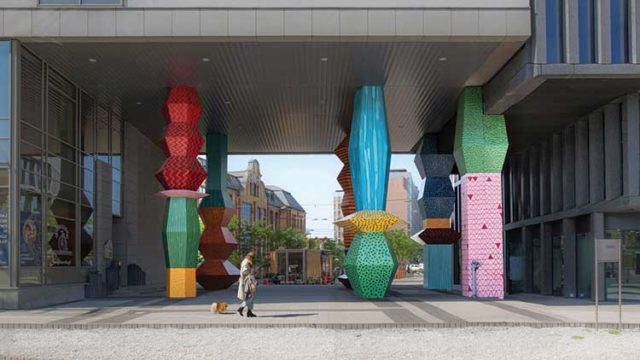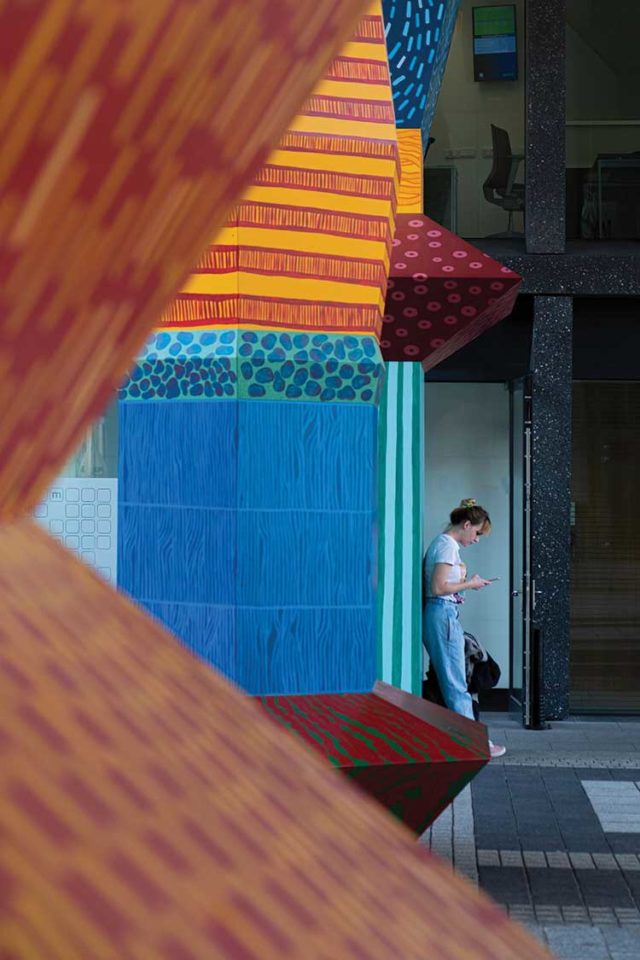In an ambitious virtual exhibition, The Museum of Craft and Design is presenting information as visual poetry interpreted by an international group of artists. “Imagining Data”shapes this subject matter into four categories: natural and environmental conditions, personal biometrics, communal movement, and randomized content.
DATA VISUALIZATION
The artists in this exhibition are developing systems to transform data into images. Paintings, drawings, sculptures, audio-visual installation, fashion, and even performance shows us what data can look like. What we divulge through online activity, our transactions, our personal and societal statuses, political affiliations, and our environment can be described by numbers and algorithms. Statistics have become a modern obsession and a way to frame our existence, especially during the Covid-19 era when contagion spikes, hospitalizations, and vaccination data flood our media each day.
CHANCE AND THE NATURAL WORLD
System interpretation is by no means a new methodology for creating art. In 3 Standard Stoppages (1914), Marcel Duchamp dropped three one-meter-long threads onto three canvas strips that were then attached to a canvas, preserving the positions as they landed. In keeping with the idea of measurement, artist Jill Baroff, in Hurricane Xaver (Baltic Sea) (2014), assimilates data from measurements of tide heights. Recorded every six minutes, the artist shows us what a hurricane looks like in minimalist concentric circles of color determined by the height of the tide.

Alicia Biala’s and Iwo Borkowicz’s Totemy (2019) is a wooden and hand-painted installation with a QR code in Poznan, Poland. More than 29 feet high, these brightly colored sculptures tell a story not obvious to the naked eye. Through the use of the QR code, a type of matrix barcode at the base of the sculpture, the viewer can learn about the relationship between statistics for deforestation, air pollution, and plastic production.
WHAT WE ARE MADE OF
In Amazon #7, Amazon #5, and Amazon #3 (2016), Louis Cameron highlights the vulnerability of individuals and the abuse and misuse of third-party data collecting. Facial recognition software is a controversial technology that maps facial components that can identify a person from a surveillance viewpoint. Taking photos of participants using the Amazon.com app, the human face is reduced to points of light signifying facial components, which are then scanned like inventory, turning humanity into a product, and literally shining a light on the commodification of our online lives.
Evan Roth’s Since You Were Born (2020)traces activity online in a massive montage to the accumulated documentation of daily Internet activity through a number of years. The artist archived traces of his interests into hanging prints, bringing the private to a public space. The seemingly endless images, including the birth of his second daughter, cover the walls of the Jeu de Paume in Paris, France. The monumental installation is a part of a series Roth has titled Internet Cache Self Portrait series (2014–ongoing).
IMMIGRATION AND MIGRATION
In Communal Movements, artists examine the political and economic implications of why populations shift. In richly hued acrylic, ink, oil and vellum on paper, Tiffany Chung pays tribute to the missing in NYT: incidents of lives lost at sea and entries from the tracking of dead & missing by IOMMissing Migrants Project (2017). For a solo exhibition taking place that same year, Chung featured work that tracked forced migration around the world. In vibrant colors and shapes, she detailed the data behind events like the post-1975 mass exodus of refugees from Vietnam, of which she was a part. Painting statistical data of the dead and missing demarcates the human cost of upheaval.
PATTERN RECOGNITION AND THE RANDOM
The human mind is, arguably, a pattern recognition generator. When confronted with random events and information, we try to make sense of chance. The unpredictable comes in many forms, and in Nina Katchadourian’s Talking Popcorn (2001/2019), this form includes no small amount of humor. This sound sculpture grew out of her interest in translation, and Talking Popcorn, using principles of Morse Code, transcribes the sounds from popping corn into language. The artist explains, “A microphone in the cabinet underneath the popcorn machine picks up the sound of popping corn, and a laptop hidden in the pedestal runs a custom-written program that translates the popping sounds according to the patterns and dictates of Morse Code. A computer-generated voice provides a simultaneous spoken translation.” The machine’s first word was “we.”
We, indeed. Imagining Data, becasue it is not limited by the constraints of a physical gallery space, introduces us to artists, ideas and spaces around the globe as we consider the age of information — together.
The Museum of Craft and Design is now open to the public with two physical exhibitions: “Design by Time” and “Encoded Holidays: Gary Hutton x Tom Bonauro”: Wed.–Sat. 10 a.m.–5 p.m. and Sunday noon–5 p.m. through Aug. 15, $10, 2569 Third Street, 415-773-0303, sfmcd.org
Sharon Anderson is an artist and writer in Southern California. She can be reached at mindtheimage.com.





